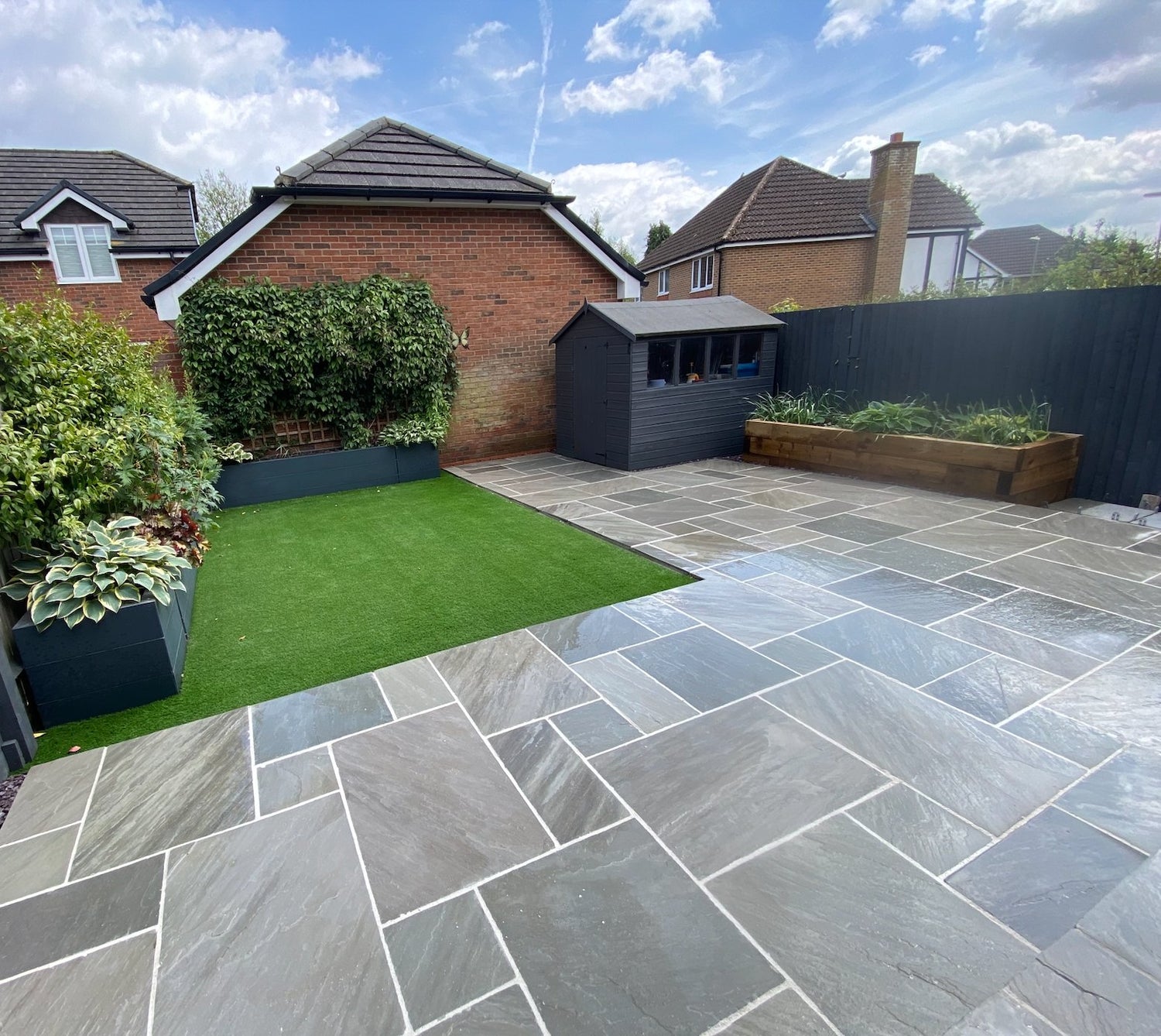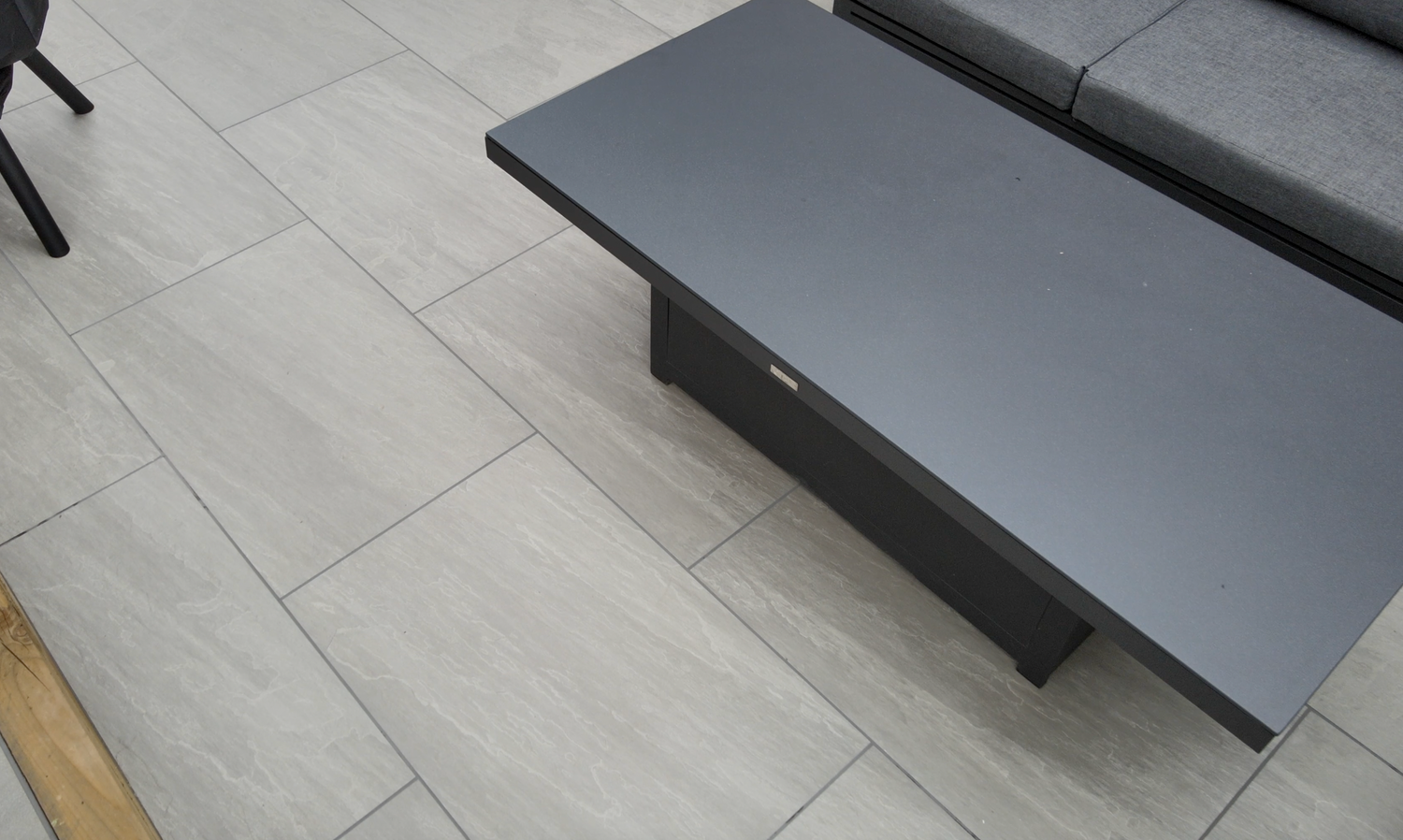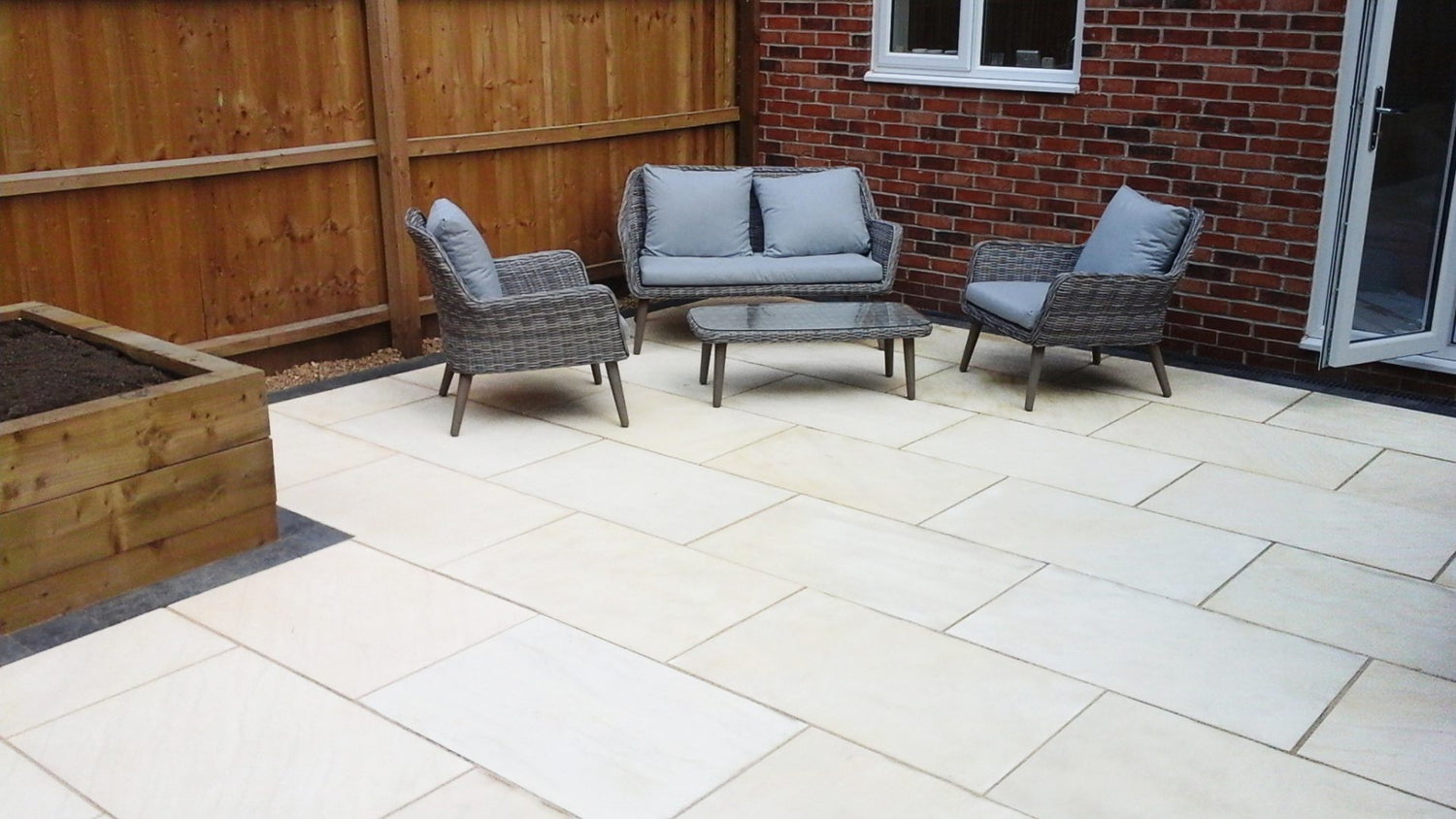
Indian Sandstone Paving Colours for A Patio - A Comprehensive Guide
Share
Indian sandstone is one of the most popular paving materials, celebrated for its natural beauty and the variety of colours it offers. This article will explore the different Indian sandstone colour options available, helping you gather paving ideas for your patio, pathway, or driveway project. Whether you’re interested in the subtle tones of beige or the boldness of red sandstone, understanding these options will guide you in making the best choice for your outdoor space.
Below is a quick overview of some of the most popular Indian sandstone paving colours and their industry-standard names:
| Sandstone Colour | Colour Description | Common Indian Sandstone Names |
|---|---|---|
| Beige Sandstone | Warm beiges with light brown and peach streaks | Autumn Beige, Harvest Gold, Mint, Vanilla, Ivory |
| Brown Sandstone | Light to deep brown tones | Raj Green, Rippon Brown, Modak, Camel |
| Red Sandstone | Pale pinks to deeper rusty reds | Agra Red, Lalitpur Red, Gurdha |
| Grey Sandstone | Light silvery to charcoal greys | Kandla Grey, Kotah Black, Sagar Black |
| Yellow Sandstone | Golden yellows with orange undertones | Jaisalmer Yellow |
| Buff Sandstone | Earthy beiges, browns, and terracottas | Golddust, Harvest Buff |
| Green Sandstone | Mossy greens and olive tones | Fossil Mint |
| Purple Sandstone | Lavender and plum purple hues | Raveena |
| Multicolour Sandstone | Varied blended tones | Rainbow |
Now, let’s explore the most popular Indian sandstone paving colours and their characteristics in more detail.
Beige Indian Sandstone

Autumn Beige is a light neutral sandstone with subtle warm peach undertones. Mint features cool green-beige hues, while Vanilla is a very pale cream. Ivory has a warm golden tone, perfect for traditional designs.
Beige Indian sandstone pairs beautifully with natural materials like wood and greenery. The lighter shades give a refined, elegant appearance, making it easy to incorporate into any style, from traditional cottage gardens to modern architectures.
Brown Indian Sandstone
Rippon Brown features a rich chocolate brown hue with lighter brown mottling for added depth and texture. Raj Green showcases earthy olive-brown tones reminiscent of natural stone.
Modak has a deep reddish-brown colour that provides a vintage, weathered look. Camel creates a warm neutral backdrop with its caramel and honey brown tones.
Browns exude a welcoming, earthy charm. They hide dirt well, making them very practical for outdoor use. Mixing brown shades can create rustic Old World styles, or you can use lighter tans for a more contemporary vibe.
Red Indian Sandstone (Modak)

Agra Red displays vibrant cherry red hues that vary from pale pinkish-reds to deeper oxblood tones. Lalitpur Red is a brighter orange-red that evokes Mediterranean flair, while Gurdha features dramatic deep berry reds.
Reds make a bold, eye-catching statement. They instantly create curb appeal and complement greenery, bricks, timbers, and traditional architecture. Proper sealing is recommended to protect red’s vibrancy in direct sunlight.
Grey Indian Sandstone

Kandla Grey exhibits cool antique silver greys, ranging from light misty grey to deeper charcoal. Kotah Black features smoky dark charcoals with distinctive black mineral deposits, while Sagar Black has an intense jet-black appearance.
Grey Indian sandstone offers incredible versatility, from modern industrial designs to traditional aesthetics. Mixing grey shades can create patterns, or you can use them alone for a refined monochromatic look. This colour pairs beautifully with metals, concrete, furnishings, and contemporary buildings.
Unique Coloured Sandstone
Looking for something more unusual? Indian sandstone also comes in exotic shades like purple, green, yellow, and multicoloured blends.
- Fossil Mint features muted sea-green tones with a textured finish.
- Raveena showcases regal purple hues.
-
Rainbow cleverly combines multiple colours for added depth and interest.

These specialty colours work perfectly as accents, bands, or custom designs. Always view a large sample before purchasing.
Choosing the Perfect Indian Sandstone Colours
With so many options, how do you select the ideal sandstone colour? Consider the overall style, existing colours, and surroundings:
- Neutrals like beige and grey match any design aesthetic.
- Warm earth tones like brown and red create cozy natural spaces.
- Bold colours make exciting statements but may clash with some colour schemes.
- Lighter colours show dirt more readily, while darker shades conceal it.
- View large samples during different times of day to see how light affects the colour.
You can also mix multiple Indian sandstone shades in custom patterns. Combining colours, textures, and sizes gives you endless possibilities.
How is Indian Sandstone Coloured?
Indian sandstone is created through natural processes, and its wide range of natural colours comes from the mineral composition and inherent properties of the stone. The minerals found within the sandstone produce the vibrant hues and variation.
Some of the key factors that determine sandstone colour are:
- Iron Oxides - Iron oxide minerals like hematite lend red, orange, brown, and yellowish tones. Higher iron content creates richer reds and earthy browns.
- Other Mineral Deposits - Minerals like manganese can contribute to purple, grey, and black sandstone. Calcite creates creamy white.
- Stone Density - Denser sandstone with tightly compacted grains produces darker colours. Lo oser grains create paler sandstone.
- Stone Origin - The quarry and region where the sandstone originated impact the minerals and colours.
- Weathering - Long-term exposure and weathering can mildly shift some sandstone hues and add patina.
The varying combination of these natural factors results in Indian sandstone's diverse colour palette, suitable for any design style. Understanding what contributes to the colours allows you to pick the perfect sandstone for your landscape needs.
What is the Most Popular Indian Sandstone Colour?
Some of the most popular and commonly used Indian sandstone colours include beige shades like Autumn Beige and Harvest Gold, browns like Raj Green and Rippon Brown, and classic greys like Kandla Grey. Neutrals and earth tones tend to have the widest appeal.
Will Indian Sandstone Change Colour Over Time?
Indian sandstone is quite stable and colourfast. However, very light and bright colours like Mint, Ivory, and Vanilla may slowly mellow and patina to have warmer yellow undertones when exposed to consistent sunlight. Reds and purples can also fade slightly without proper sealing.
Does Washing or Weathering Alter Indian Sandstone Colours?
Indian sandstone's natural earthy tones are quite resistant to weathering or colour changes from washing. However, lighter sandstones with softer minerals could slowly develop more patina and darken slightly over many years of exposure to the elements. Annual sealing helps protect the original vibrancy.
Should I View Indian Sandstone Samples Before Deciding on a Colour?
It's highly recommended to view large on-site samples of Indian sandstone before making a final selection. Colours can look different in person than on a computer screen. Seeing the sandstone in different lighting at various times of day ensures you get the right colour for your space.
Related Posts
-

UK Garden Statistics and Trends 2024
UK Garden Statistics and Trends 2024 General UK Garden Statistics The vast majority of UK households have access to ...
-

Can I lay Paving on Soil or Mud?
Technically, yes – you can lay paving stones or slabs directly onto exposed topsoil however, laying a sub-base will e...
-

How Much Does a New Patio Cost?
A new patio in the UK typically costs between £80-£150 per square meter. For a 40-50 sqm patio, expect to pay £2,000-...
-

What Different Sizes Do Paving Slabs Come In?
When planning a patio or outdoor paving project, one of the key decisions is choosing the right size paving slabs. ...
-

Can You Pressure Wash Indian Sandstone?
Indian sandstone is a popular choice for outdoor paving due to its durability and attractive appearance. However, li...
-

Is Sandstone Paving Permeable? Is it porous?
Sandstone's porous nature enables it to absorb rainfall, qualifying it as a permeable paving variety. However, seali...
-

Where Does Natural Sandstone Paving Come From?
Sandstone begins deep underground, formed over eras as minerals and sediments fused under pressure. Powerful forces ...
-

5 Paving Ideas for Small Gardens: Maximise Your Outdoor Space
Front of House When considering paving ideas for the front of your house, it's crucial to select ones that complem...
-

9 Paving Ideas for Front of House: Enhancing Curb Appeal with Style
The facade of a house plays a pivotal role in defining its character and curb appeal, and the choice of paving can s...
-

9 Summer Garden Paving Ideas UK
Summer gardens offer a vibrant canvas for homeowners to express their style while enhancing outdoor living spaces. G...
-

8 Garden Paving Ideas for 2024
It's time to refresh your garden's look for 2024 and an easy way to do that is with some new paving. With so many opt...
-

How to remove moss from patio paving
Moss growth is a common issue for patio paving, especially in damp, shaded areas. While moss may seem harmless, it ca...
-

How much does sandstone paving cost?
When choosing new garden pavers, sandstone offers homeowners an enticing middle-ground - more durable than basic conc...
-

Why Do Paving Slabs Crack And How To Repair Them
Seeing cracks appear on your patio or driveway can be disheartening after investing time and money into installing be...
-

How to lay paving in winter (Tips & Tricks)
How Cold Temperatures Impact Paving Projects The primary concern when working in cold weather is ensuring proper curi...
-

Sub Bases For Patios
Building the Perfect Patio Base: A Comprehensive Guide When planning an outdoor living space, understanding proper ba...
-

Pros and Cons of Porcelain Paving
Are you considering adding porcelain paving to your outdoor space? It's important to weigh the pros and cons before ...
-

Understanding Paving Slip Ratings: A Comprehensive Guide
A paving slip rating, also known as a slip resistance or anti-slip rating, is a measure of how slippery a surface...
-

Stunning Garden Water Feature Ideas - Enhance Your Outdoor Space
Garden water features are decorative elements that incorporate water into a garden, adding beauty and a sense of ...
-

How to Stop Weeds in Block Paving: Expert Tips andTricks
Weeds growing between the blocks of your paving can be an unsightly and frustrating problem. Not only do they make y...
-

How to clean paving without a pressure washer
A patio cleaner is a cleaning solution designed specifically for removing dirt, grime, and stains from outdoor patio...
-

How to Grout Paving Slabs – Expert Tips and Techniques
Pointing paving slabs is an important step in the process of installing them. Grout is a mixture of cement, water...
-

Block Paving Guide | What Does it Cost? | How Much Per m2?
Block paving is a versatile and durable option for creating driveways, patios, and paths. This method involves using...
-

Porcelain VS Ceramic Paving
Porcelain paving is non-porous and more durable than ceramic paving, which is more porous and prone to stains and wea...
-

Sandstone V Porcelain Paving - (Style Comparison and Distinctions)
When choosing materials for your patio or driveway, two of the most popular options are sandstone paving slabs and p...
-

Understanding Gradients and Falls for Paving and Drainage (2024)
When it comes to paving and drainage projects, understanding the correct gradients and falls is essential for ensuri...
-

Jointing and Pointing For Paving (Sand & Cement Mix)
Patio pointing is important for both looks and durability. It protects the layers under your paving, stops weeds, and...
-

How to Lay Paving on Sand and Cement: Expert Advice and Tips
Paving on Sand and Cement: A Comprehensive Guide When it comes to enhancing your outdoor space, paving is a popular ...
-

Pros and Cons of Sandstone Paving
Pros & Cons of Indian Sandstone Paving Indian sandstone paving is a natural and durable option that adds both bea...
-
Does Patio Paving Need Edging? A Comprehensive Guide
In this article, we'll explore the importance of patio edging, the different types of edging materials available, and...
-

Pet Friendly Paving - What is the best paving for a dog-friendly garden?
Creating a dog-friendly garden requires choosing the right paving materials to ensure your furry friends can enjoy t...
-

Patio Paving Laying Patterns Guide
Paving patterns can transform an ordinary outdoor space into a stunning and eye-catching area that complements your ...
-

Patio Kits vs Single Size Paving Slabs: Which To Choose?
When designing a patio or outdoor space, one crucial decision is whether to use a patio kit (also known as patio pack...
-

Are paving slabs suitable for driveways?
This is a question many homeowners ask when it comes to choosing the right type of driveway surface for their home. T...
-

How much paving do you need to cover your outdoor space?
Planning an outdoor paving project is exciting, but it’s crucial to accurately estimate the amount of paving needed b...
-

What is the Best Paving for Patios?
When it comes to choosing the best paving for patios, there are a variety of factors to consider, such as durability,...
-

Sandstone v Limestone v Porcelain: The Pros and Cons of Different Garden Paving Materials
Transforming your outdoor space involves choosing the right paving material, and porcelain and sandstone are two of t...
-

Are Paving Slabs Cheaper Than Decking?
Transforming your backyard into the ultimate outdoor oasis can be challenging when choosing between paving slabs or d...
-

How to lay a patio - An expert guide to laying paving slabs and patterns
There are a few things to consider before laying a patio, such as the type of paving stones and the laying pattern. Y...
-

How to cut Sandstone Paving?
When it comes to prepping your garden for a new patio, you may consider different designs that require your paving to...












































